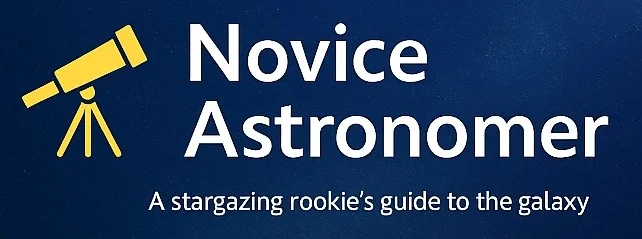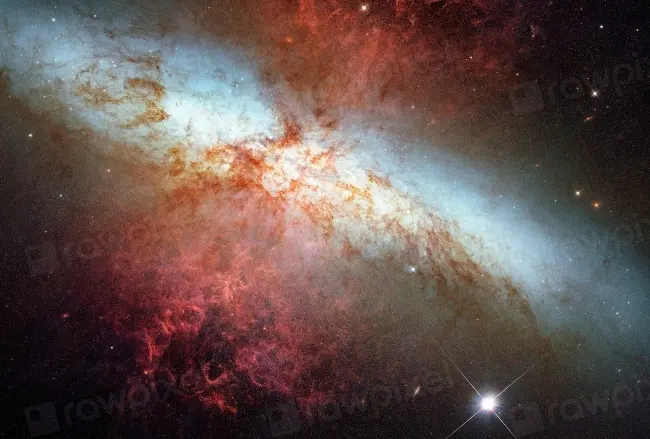It took less than a century for scientists to go from thinking the universe was eternal to debating whether it ends in a crunch, a rip, a slurp—or a whimper.
Our recent astronomy club meeting featured an uplifting discussion on the end of existence. This cheery topic was brought to us by long-time club member Gary. Jokes aside, his presentation really was a mind-blower — delivered on just two sheets of chart paper. Because that’s all he needed.
What follows is a mash-up of my notes on Gary’s talk plus the side-orbits of research I spun into afterward.
🚀 Evolution of the Debate
So, how will the universe end? Apparently no one in modern science was even asking this question until recently. Before the 20th century, the prevailing assumption was that the universe was static and eternal. Always here, always will be. This became known as the steady-state universe.
Then in the 1920s, better telescopes allowed Edwin Hubble to make a shocking discovery: the distance between galaxies was increasing. The deeper he looked into space, the faster galaxies seemed to be flying apart, as if the whole fabric of space was stretching. The universe was expanding. This threw a serious monkey wrench into Einstein’s calculations.
❌ The Cosmological Blunder
Einstein leaned on the prevailing belief in a static universe as he formulated his theory of relativity. To make the math work for a universe that wasn’t collapsing, he added something he called the cosmological constant—basically a built-in “anti-gravity” term that held the formula in place. Without it, his math predicted collapse or expansion. Neither matched the static assumption. When expansion was confirmed, he dismissed the constant as a blunder… though the idea was eventually resurrected in a new form.
From Steady-State to Big Bang
Hubble’s discovery also led scientists to speculate on its implications. If the universe is expanding, then it must have once been very small and dense. By the 1930s–40s, expansion was widely accepted. But did that mean the universe had a beginning? Not everyone agreed.
In 1948, Fred Hoyle, Hermann Bondi, and Thomas Gold tried to rescue steady-state theory by modifying it. They proposed continuous creation: as galaxies spread out, new hydrogen atoms pop into existence to keep things balanced.
Then in 1949, George Gamow and colleagues developed the model we now know as the Big Bang.
📻 Hoyle’s “Big Bang” Snark
In a BBC lecture, Fred Hoyle derisively contrasted his steady-state model with the idea of a finite beginning: “the hypothesis that all the matter of the universe was created in one big bang…” He later claimed he wasn’t mocking, just being vivid for radio. Either way, the name stuck.
Later, in 1964, Arno Penzias and Robert Wilson were perplexed by a faint radio hiss that they could not eliminate. It turned out to be cosmic microwave background (CMB) radiation: the faint, uniform afterglow of the universe’s fiery birth. This was exactly what the Big Bang model predicted. Steady-state was finished.
Their discovery—made with a horn antenna intended for satellite communication—provided a new field of study for scientists, ultimately leading to the development of sophisticated instruments and maps of the universe showing the background radiation.
By the 1970s, the big question became: If the universe had a beginning, how will it end? Three main scenarios were proposed:
- expand indefinitely,
- stop expanding and hold, or
- stop expanding and contract.
🧠 The Science So Far
A few concepts matter if you’re going to talk about the end of everything. Gary gave us an entry-level overview of the main players.
Relativity vs Quantum Mechanics
Relativity explains the macroscopic universe — planets, galaxies, spacetime. Quantum mechanics explains the microscopic universe — the world of atoms and subatomic particles. The wild part is—they don’t match up! Somehow, the inside of the atom plays by a completely different set of rules than the outside.
Dark Matter & Dark Energy (aka our giant question marks)
Astronomers throw these terms around a lot, but here’s the reality: they’re basically labels for mysteries we don’t yet understand.
In the 1970s, Vera Rubin noticed galaxies spinning in ways that didn’t make sense. The outer arms were moving faster than the visible matter could explain. This confirmed the existence of dark matter — an unseen source of gravity, suspected since the 1930s. We can’t see it, and we don’t know what it’s made of. Maybe it’s unknown particles. Maybe our math about gravity is off.
In the 1990s, astronomers discovered the universe’s expansion was speeding up. That driver was labeled dark energy. Many models treat it as Einstein’s old constant reborn, though it’s not confirmed — it might be something entirely new.
We don’t actually know if these are “real things” or just placeholders until physics catches up. What we do know is that the universe doesn’t behave the way it should if we only count the stuff we can see.
🌀 Shapes of the Universe
Then there’s geometry. What shape is the universe? Astronomers say there are three main possibilities:
- Closed (sphere/torus/donut): Expansion could slow and reverse. That’s where Big Crunch or Big Bounce endings live.
- Open (saddle-shaped): Expansion goes on forever. Think Big Freeze/Whimper.
- Flat: Expansion still goes on forever, but with extra room for multiverse weirdness—like “brane” universes colliding. This shape is strongly favored by current data.
Gary helped us picture these complex ideas using simple imagery: a donut, a saddle, and a sheet. And here’s the key: shape doesn’t just describe geometry — it sets the stage for how the universe ends. Current observations suggest the universe is almost perfectly flat, which tips the odds toward endless expansion.
🔮 14 Theories of the End
Scientists have proposed dozens of endings for the universe. Gary narrowed it down to 14 of the most popular (and most colorful) contenders — the ones you’re most likely to run into in books, lectures, and late-night rabbit holes. Some are data-supported, others are wild thought experiments.
Grounded in Mainstream Physics
1. Heat Death (Big Freeze / Big Whimper)
Stars die, energy spreads thin, everything goes dark and cold. Most favored by current evidence.
2. Big Rip
Expansion keeps accelerating until galaxies, stars, and even atoms are torn apart. This one gets a lot of attention because it ties neatly into dark energy.
3. Big Crunch
Expansion reverses, universe collapses. Recent DESI (galaxy-mapping mega-telescope) data throws a possible curveball—dark energy might be fading, which could tip the scales toward wild collapse.
4. Big Bounce
Collapse leads to another Big Bang—cosmic yo-yo. Our current understanding of dark energy complicates this theory by suggesting the universe will never contract. However, new research may offer an amendment to that story.
5. Vacuum Decay
A bubble of “true vacuum” forms and expands at nearly light speed, rewriting the laws of physics instantly. Some folks find this the most terrifying, because it would be instant and unstoppable. One physicist quipped: “You wouldn’t see it coming. You wouldn’t even have time to worry.” I have to agree. Seems the most painless to me.
6. Black Hole Era
Everything ends up in black holes, which eventually evaporate. Gary was quick to remind us: black holes aren’t cosmic vacuums—outside their event horizon, objects can still orbit safely. Still, some scientists believe they could dominate in the far future.
7. Eternal Inflation
Expansion goes on forever, spawning endless new universes.
Speculative/Fringe
8. Cosmic Rebirth (Phoenix Universe)
An endless cycle of bangs and crunches.
9. Heat Death + Quantum Fluctuations
Freeze… except with random bursts of order, like “Boltzmann brains.” These are hypothetical self-aware entities that could randomly pop into existence from chaos, purely from quantum fluctuations. In a heat-dead universe, they might outnumber “real” observers. Creepers.
10. Multiverse Collision
Flat, membrane-like universes colliding. This is a string theory thing, where our universe and others coexist in parallel sheets, called “branes.” The idea is that these flat, brane-like universes could one day smash into one another.
A chilling possibility: ours is a matter universe, but what if there’s an antimatter universe out there? We would not want to collide with that.
11. Big Slurp
Universe sucked into a lower-energy vacuum. Like a cosmic milkshake straw.
12. Big Slush
Patchy, uneven decay of structure.
13. Big Split
Forces or dimensions unravel, tearing reality apart.
14. Simulation Shutdown
If this is all a simulation, someone might just flip the switch. Gary admitted this one was more philosophy than physics, but it’s popular in late-night debates — what if reality itself just gets unplugged?
My personal favorite? The Big Whimper. Only because I’m a T.S. Eliot fan: “This is the way the world ends / Not with a bang, but a whimper.”
💡 What I Learned
During wrap-up, Gary used relativity to explain perspective: a ball dropped from a moving train looks different depending on where you stand. I’m fuzzy on the details, but the takeaway that stuck with me was that perspective changes what you see—even in physics.
Our perspective on the universe is limited, though perhaps a little less than it was a century ago. Maybe in another hundred years, scientists will describe its fate in terms we can’t yet imagine. Personally, I suspect “dark matter” and “dark energy” will give way to more specific explanations—things invisible to us for now. But what do I know? I’m just a novice.
Why It Matters (Even If We Won’t Be Around)
Thinking about the end of the universe isn’t just sci-fi daydreaming. These theories push scientists to test the known limits of physics, from relativity to quantum mechanics. They’re also tied to mysteries like dark energy, which still defies explanation. Even if none of us will be here to see the finale, researching these scenarios sharpens our understanding of the universe today — and reminds us that asking “how does it all end?” is part of being human.
📚 Sources & Further Reading
- NASA: Dark Energy, Dark Matter – clear overview of the two biggest cosmic mysteries.
- ESA Planck Mission – data that mapped the cosmic microwave background in exquisite detail.
- NASA: The Big Bang – history of the Big Bang and its evidence.
- DESI Collaboration – ongoing survey measuring the expansion of the universe with dark energy in mind.
- Higgs Centre: What’s a Boltzmann Brain? – a short, fun outreach explainer from the University of Edinburgh’s Higgs Centre for Theoretical Physics.

